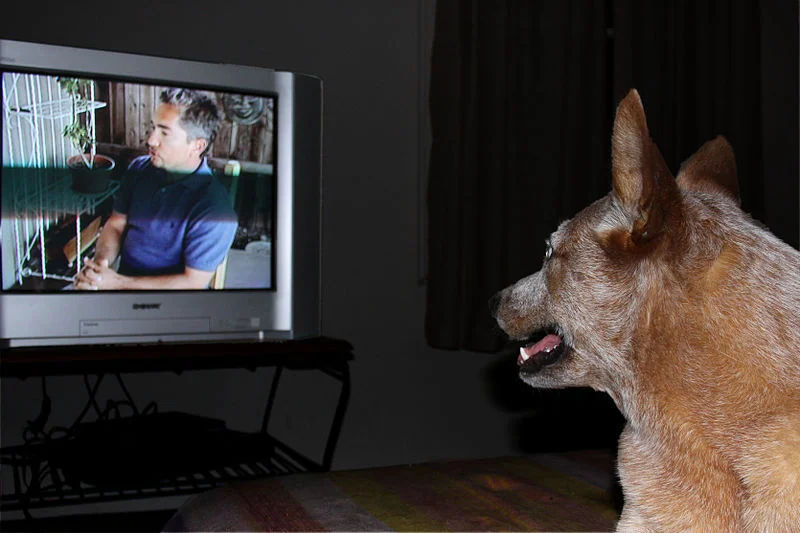What Dogs See When They Watch Television? Dogs see a lot when they watch television. They see people, places, things, and events. Some dogs might see more than others, depending on their breed and personality. Dogs also seem to enjoy watching television, which may be why it’s so popular with them.
According to a study published in The Quarterly Journal of Experimental Psychology, dogs see television in much the same way as humans do. In fact, they seem to understand what’s happening onscreen even better than we do – at least when it comes to understanding human emotions.
What Dogs See When They Watch Television? How Do Dogs See TV?
It turns out that dogs process televisions and screens differently than people do, however it has been discovered that dogs frequently recognize what they are seeing and hearing through these devices. There are some canines that aren’t interested in watching television, while other dog owners claim that their canine companions are captivated by electronic screens.
When it comes to the topic at hand, you won’t be surprised to find that dogs enjoy seeing other canines interact and play with one another. Animals of the same species have an innate tendency to congregate together.

Dogs, on the other hand, have a very different perspective on the world: The eye of a dog contains only two types of cones, as opposed to three in the eye of a human, which provides them with dichromatic vision.
Also Read: Why Is My Dog Sneezing So Much?
As a consequence of this, dogs are unable to discern between as many hues as (the vast majority of) people can. On top of that, dogs are far more sensitive to settings when there is a lack of light.
In addition to their coat color, several breeds of dogs have variable degrees of visual acuity. The visual streak in the canine eye is the part of the retina that has the most acute vision.
However, the size, shape, and quantity of the dog’s receptors are not consistent between breeds or individuals. The variations in the structure of the eye play a significant part in the way in which dogs perceive their surroundings.
The next aspect to consider is the flicker factor. On the whole, people are unable to detect the flickering of a television set when the frequency is greater than 55 Hertz (Hz). On the other hand, dogs that have a superior ability to perceive motion have been tested at rates as high as 75 Hz.
Due to the fact that televisions have a refresh rate of 60 hertz, we perceive this as a smooth motion, however dogs would interpret the screen as a series of images that are constantly flashing.
The high-definition graphics and crystal-clear sound of today’s sophisticated televisions (as well as smartphones) provide our young children with an unobstructed look into a different world. Dogs are able to see smooth action thanks to the significantly improved refresh rates of modern HD and 4K televisions. A dog’s reaction to the television might also be significantly influenced by the sounds that are broadcast.
Researchers observed that puppies pay more attention to video content that includes noises of praising, whimpering, and barking. This is something that most people who are responsible for the care of pets already know.
Television for Dogs
DOGTV was established in 2012 in order to fulfill these specific requirements for television viewing.
The 24-hour channel has a higher frame rate than the others, displays colors that are better suited to a dog’s vision, and was developed specifically with sedentary dogs in mind.
The company DOGTV claims that the network was “scientifically constructed to provide the appropriate company for dogs when they are left alone.”
Years of research resulted in the creation of content that was specifically developed to match particular characteristics of a dog’s sense of vision and hearing and to complement the natural behavior patterns of dogs.
The end effect is an assured and content canine that has a lower risk of developing stress, separation anxiety, or other issues associated to these conditions.
Do Dogs Like Watching TV?
Even if there is a channel designed specifically for them, dogs typically only pay attention to the television for very little periods of time and only glance at it occasionally.
On the other hand, some dogs have a stronger reaction to the TV than others.
Herding breeds, for instance, tend to focus more intently on what they’re watching on television because of their fascination with things that are in motion.
Recent studies have suggested that some dogs might be paying more attention to television than ever before. A study published in the journal Applied Animal Behavior Science found that dogs who were allowed to watch television had improved attention spans, compared to dogs who were not allowed access to televisions.
Researchers believe that the increased focus on television might be contributing to the growing obesity epidemic among pets, as well as the increase in behavioral problems in children.
The Effects of Television on Dogs
Television is one of the main forms of entertainment for humans and dogs. However, research has shown that television can have negative effects on both animals. Television can have a negative impact on the behavior of dogs by causing them to become more aggressive or distracted.

Still, there are some videos that helps your dog come out of separation anxiety and set them well.
Television also has a negative impact on the attention span of dogs, which can make it difficult for them to focus on tasks that are important to them.
The majority of studies investigating the effects of television on dogs have found that dogs become agitated, withdrawn, or display signs of stress when watching TV. Some dogs even show signs of aggression when they see their owners watching television.

